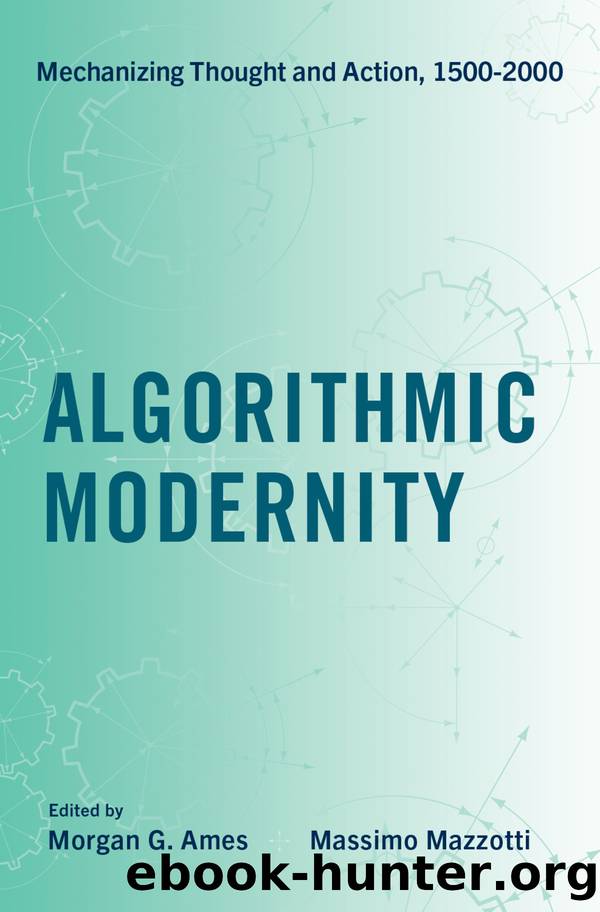Algorithmic Modernity by Ames Morgan G.;Mazzotti Massimo;

Author:Ames, Morgan G.;Mazzotti, Massimo;
Language: eng
Format: epub
Publisher: Oxford University Press, Incorporated
Published: 2023-03-15T00:00:00+00:00
A Statistical Control State
On March 4, 1933, the Bell Systemâs Walter Shewhart gave a lecture at the Graduate School on âThe Specification of Accuracy and Precision.â The lecture was delivered in the same moment that FDR delivered his inaugural lines, âThe Only Thing We Have to Fear Is Fear Itself.â39 The new president advocated that day for engagement âon a national scale in a redistribution ⦠to provide a better use of the land for those best fitted for the land ⦠helped by national planning for and supervision of all forms of transportation and of communications and other utilities which have a definitely public character.â40 This vision of America depended on a unified political order and the formation of an administrative bureaucracy that could control these projects at the state and institutional levels.
Emboldened by New Deal policy, the USDA Graduate School became a thriving educational center and a permanent feature of the Beltsville farm, though still not endorsed or funded by government bodies, which were predominantly under the control of subscribers to the associative politics of Rooseveltâs predecessor, Herbert Hoover. Throughout the 1930s, the school continued to receive widespread critique from local DC politicians and national interests that wanted separation between âuniversityâ and âgovernment.â This political backlash heightened after the USDA began to implement New Deal legislation in 1933, the year FDR instated Henry A. Wallace as secretary of agriculture. Like his father, Wallace believed that the USDA had an important role in implementing New Deal programs on the state and regional levels. It was the USDAâs role to educate the scientific community and public on what they referred to as first principled research and to implement this policy through establishing a new bureaucratic order that could sustain it.
Efforts to establish control at the state level and in scientific practice collided in the pedagogical initiatives of the USDA Graduate School that were developed for both USDA employees and the public. This included courses for USDA employees, a USDA Graduate School printing press, and a number of public lectures and conferences. A long-standing tradition of the school was to host visiting speakers from statistical experimental stations around the world. Edwards Deming directly facilitated exchanges with statisticians at Bell Telephone Laboratories and the Rothamsted Station. As early as 1927, Deming had become interested in the work of Shewhart and Bell Laboratories. By 1933, Deming facilitated Bell Telephone Laboratories and the Department of Agriculture to co-sponsor Shewhartâs commissioned talks. These talks were organized under the umbrella topic of âThe Statistical Method from the Viewpoint of Quality Control,â which would later become the title of Shewhartâs influential 1939 book, due largely to the support of the Graduate School.41 Throughout 1933, Shewhart gave four talks at the Graduate School on statistical control and the limits of variability.
Demingâs reflections on SQC make clear the collapse between industrial manufacturing and agriculture under the formation of data-driven research. He said, âwe in agriculture are faced with the same problemsâ as in manufacturing.42 However, he argued that agriculture
Download
This site does not store any files on its server. We only index and link to content provided by other sites. Please contact the content providers to delete copyright contents if any and email us, we'll remove relevant links or contents immediately.
Exploring Deepfakes by Bryan Lyon and Matt Tora(7883)
Robo-Advisor with Python by Aki Ranin(7787)
Offensive Shellcode from Scratch by Rishalin Pillay(6188)
Microsoft 365 and SharePoint Online Cookbook by Gaurav Mahajan Sudeep Ghatak Nate Chamberlain Scott Brewster(5200)
Ego Is the Enemy by Ryan Holiday(5020)
Management Strategies for the Cloud Revolution: How Cloud Computing Is Transforming Business and Why You Can't Afford to Be Left Behind by Charles Babcock(4452)
Python for ArcGIS Pro by Silas Toms Bill Parker(4261)
Elevating React Web Development with Gatsby by Samuel Larsen-Disney(3981)
Machine Learning at Scale with H2O by Gregory Keys | David Whiting(3748)
Learning C# by Developing Games with Unity 2021 by Harrison Ferrone(3295)
Liar's Poker by Michael Lewis(3252)
Speed Up Your Python with Rust by Maxwell Flitton(3238)
OPNsense Beginner to Professional by Julio Cesar Bueno de Camargo(3201)
Extreme DAX by Michiel Rozema & Henk Vlootman(3180)
Agile Security Operations by Hinne Hettema(3129)
Linux Command Line and Shell Scripting Techniques by Vedran Dakic and Jasmin Redzepagic(3119)
Essential Cryptography for JavaScript Developers by Alessandro Segala(3088)
Cryptography Algorithms by Massimo Bertaccini(3007)
AI-Powered Commerce by Andy Pandharikar & Frederik Bussler(2991)
